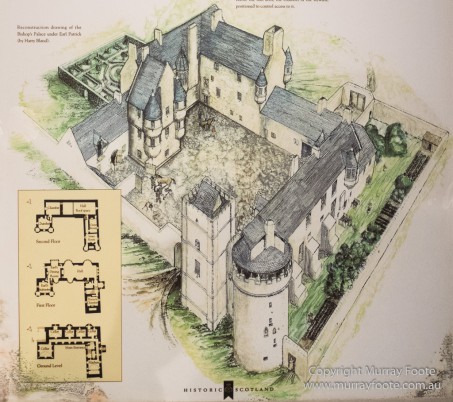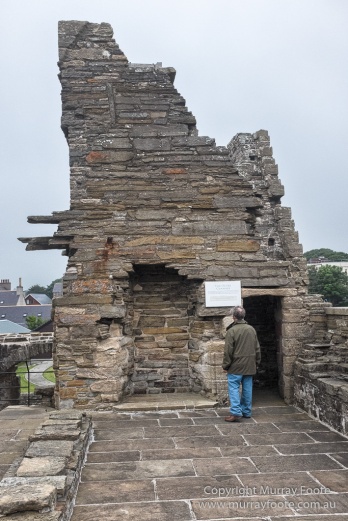Orkney, Scotland. Days 23 and 25 , 21st and 23rd July.
This is the Earls Palace in Kirkwall, the main town of Orkney. I briefly stopped here on my way to my accommodation on the day I arrived in Orkney, for a few images from the outside. Two days later I returned when it was open and photographed the inside.
This is what it looked like after it was built. The long building in the front right is the Bishop’s Palace (next post) and the L-shaped building behind it is the Earl’s Palace. The inset for floor plans is for the Earl’s Palace (from an information board at the site).
Two posts ago we saw the Earl’s Palace at Birsay, built by Earl Robert Stewart, illegitimate son of James V and half brother of Mary Queen of Scots. He acquired the Bishop’s Palace at Kirkwell in 1570 from Bishop Adam Bothwell (who visited Orkney twice only). The Earl’s Palace was built by his son, Patrick Stewart between 1601 and 1607.
The Stewart Earls had invidious reputations, especially Patrick. He was known for cruel and arbitrary justice and building his palace with unpaid forced labour. He conducted armed raids and seized houses of his rivals. Notwithstanding inheriting an earldom already in debt, be undertook an ambitious building program including both the Palace here and a castle at Scalloway in Shetland (which we shall see in due course).
In 1603 the King restored the Bishopric of Orkney and reinstituted the church estates. This caused a great loss in revenue for Patrick who resorted to increased taxation on other landowners and thus caused intensified opposition. In 1607 he was required to hand over his newly constructed palace to the Church. He still occupied it in 1610 but by then he had lost the king’s support and was arrested and sent to prison for five years.
From prison he encouraged his son Robert to rebel. In 1614 Robert seized both the Kirkwall Palace and the Kirkwall Castle (which no longer exists). However, he was defeated by the combined forces of the Bishop of Orkney and the Earl of Caithness. Both Stewarts were executed in 1615.
.
While Patrick Stewart had a reputation as a tyrant, that was mainly for the effect he had on other landowners. Probably all earls were vicious suppressors of their poorer subjects. The fall of the Stewart Earls, though, led to a change in the legal system. The previous system or Udal Law, derived from the Vikings, gave freehold ownership to small farmers without the need to hold title deeds. Scottish Feudal Law largely replaced this after Patrick. I’m not sure how this played out but on the mainland all ownership was concentrated in the Lairds until very recently and still largely is.
In 1614, the Church took possession of both the Bishop’s and Earl’s Palaces but they did not hold them for many decades. In 1638, when the Covenanters defeated Charles I in the first phase of the Civil War, they abolished Episcopy. In other words, they abolished hierarchy in the Church and there were no Bishops.
In 1643, Charles granted the Earldom to William Douglas, Earl of Morton but the Earl’s authority did not survive the Civil War. In 1653, the Palaces were used as accommodation for Oliver Cromwell’s troops. Episcopy was restored with the Restoration and a Bishop moved back in in 1671 but this did not last long either because the Glorious Revolution in 1688 saw Episcopy abolished again, this time for good. The Palaces were already severely deteriorated by this time and they fell into ruin during the eighteenth century.
 This is the Between Room and probably the room of the Steward, the person who oversaw the running of the Palace and controlled security. It’s on the first floor and facing one of the corner turrets.
This is the Between Room and probably the room of the Steward, the person who oversaw the running of the Palace and controlled security. It’s on the first floor and facing one of the corner turrets.
There’s an irony here. From the 12th century to 1371 the High Stewards of Scotland were stewards to the Scottish King, for most of that period the House of Dunkeld. This was an hereditary office and the family who held it were therefore called the Stewarts. From 1371 the Stewards became Kings (and eventually gave rise to the current Elizabeth Saxe Coburg Gotha, alias Windsor).
So this is the room of the Steward to the Stewart who in turn was son of the bastard son of a Stewart who was King and whose family had for centuries been Stewards to the King.
This is the Great Hall, the principal public room in the Palace, where Earl Patrick dispensed his own peculiar brand of justice.
This is the Dining Room. Its appearance is quite different without the elaborate wooden panelling and tapestry hangings it would once have featured.
As a stone building it would have been cold in winter and one wonders what it would take to keep that huge fireplace fed, especially in a land of very little wood.
These are the stairs from the first floor to the second. The wall seems to have been patched up with some incongruously new-looking mortar.
This is the Bed Chamber. Not just a bedroom but also a place where Patrick would have entertained visitors, friends and family.
Here we are at a turret in the Bed Chamber, looking past a turret in the Main Hall, to the corner of the L-shaped Palace where the entrance is.
.
We can see the turret the previous picture came from. This is from the end of the second story, now open to the sky.
The Outer Chamber, originally a guest room.
The Inner Chamber, also originally a guest room. Both Inner and Outer Chambers had their own fireplace, latrine closet and access. This one was also the quarters of Major Ponsford when he billeted here in 1653 with his Cromwellian troops.
This is the fireplace of a small room half-way up the stairs and above the kitchen. It may be the one described as the Doctor’s Chambers in the inventory of 1653. It is uncertain who this Doctor was, perhaps one accompanying the Cromwellian troops at that time.




















Pingback: Journey to North Atlantic – Itinerary and Index of Posts « Murray Foote
Pingback: Orkney Monochromes « Murray Foote
Pingback: Scalloway Castle « Murray Foote
Thank you so much for the images of the Earl’s Palace. Knowing full well the evil reputation of the Stewarts on Orkney (all well deserved), I must humbly admit that I am a descendant of Earl Robert through his daughter Elizabeth Stewart, who married James Sinclair. I am currently writing a blog narrative about John Stewart, Lord Kincleven and 1st Earl of Carrick (Orkney), and have become intrigued with the machinations of these brothers and Patrick’s son Robert. May I contact you later about using some of these images for my blog? Of course, I would provide standard MLA-style documentation. Great photography and very informative text!
Eileen Cunningham
Wichita, KS USA
LikeLike
Thanks very much, Eileen. Certainly, I would be very happy to cooperate. Sounds like a great project.
LikeLike
We visited Kirkwall a number of years ago on a cruise ship and unfortunately didn’t get to visit the palace. Cruise ship travel is great but many times there is just not enough time to see everything. Your guide is excellent. My surname is Slater and we stopped in at Sclater’s store however the owner was not in. And there are Sclater’s in the cemetery. All probably very distant relatives.
LikeLike
Thank you Dennis. A plethora of amazing historical sights in the Orkneys and the Shetlands. I imagine I had much more time than you but even so, it would be nice to go back one day with much more time.
LikeLike